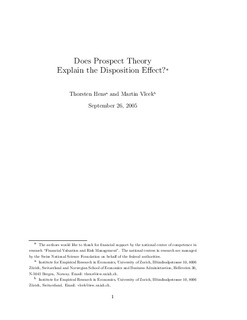| dc.contributor.author | Hens, Thorsten | |
| dc.contributor.author | Vlcek, Martin | |
| dc.date.accessioned | 2006-07-11T07:38:28Z | |
| dc.date.available | 2006-07-11T07:38:28Z | |
| dc.date.issued | 2005-09 | |
| dc.identifier.issn | 1500-4066 | |
| dc.identifier.uri | http://hdl.handle.net/11250/163747 | |
| dc.description.abstract | The disposition effect is the observation that investors hold winning stocks too long and sell losing stocks too early. A standard explanation of the disposition effect refers to prospect theory and in particular to the asymmetric risk aversion according to which investors are risk averse when faced with gains and risk-seeking when faced with losses. We show that for reasonable parameter values the disposition effect can however not be explained by prospect theory as proposed by Kahneman and Tversky. The reason is that those investors who sell winning stocks and hold loosing assets would in the first place not have invested in stocks. That is to say the standard prospect theory argument is sound ex-post, assuming that the investment has taken place, but not ex-ante, requiring that the investment is made in the first place. | en |
| dc.format.extent | 1191267 bytes | |
| dc.format.mimetype | application/pdf | |
| dc.language.iso | eng | en |
| dc.publisher | Norwegian School of Economics and Business Administration. Department of Finance and Management Science | en |
| dc.relation.ispartofseries | Discussion paper | en |
| dc.relation.ispartofseries | 2005:18 | en |
| dc.subject | disposition effect | en |
| dc.subject | prospect theory | en |
| dc.subject | portfolio choice | en |
| dc.title | Does prospect theory explain the disposition effect? | en |
| dc.type | Working paper | en |
